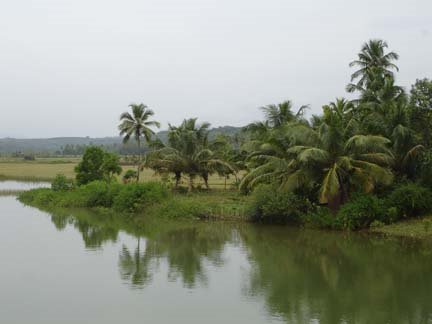The coastal town Bekal, well known for a picturesque Fort, is about 15km south of Kasargod, in Kerala. The Fort more or less hexagonal in shape, covering an area of about 40 acres,with 12m high walls, has been built on a granite-laterite promonotary projecting into the coastline of Arabian Sea on three sides of the hexagon. It is well known practice during the past period of kings to build forts on promonotories in the interest of security.
The Fort has been constructed using laterite bricks.The fort area has been developed as a popular spot for tourism. According to historical data compiled by Salattore the fort was built by Shivappa Nayaka of Keladi around 1650 CE, during his occupation of coastal stretch of Tulunadu and Malabar. There is also an opinion that an ancient fort existed in the area originally built by Kolathiri kings of Kerala ca. 12th Century. The fort might have been renovated by the Portuguese and later rebuilt by Hiriya Venkatappa Nayaka and later completed by his son King Shivappa Nayaka. After Portuguese and Nayaka Kings of Keladi/ Ikkeri, Tippu Sultan ruled over this region in 18th Century also modified the Fort to carry out gun attacks on the enemies.
Bekal-Dekkal
According to some local legends, the name ‘Bekal’ is derived from the words Benda kalla referring to the burnt bricks used in the ancient fort. The place is also sometin\mes referred to as ‘Dekkal’ (‘Dekallu’) meaning projecting rocks (promonotory) in Tulu language. (Compare the Tulu word ‘Dekallu’ with ‘Dekkuli’, projecting tooth).Alternately, the name Dekall also could have been ‘Dekki kall’ (=washed stones, in Tulu) alluding to the wave washed granite-granulite rock exposures on the beach-line of the Bekal Fort.
It is said that during the past royal history the place was also known as ‘Baliakulam’. In Kerala history the place was also known for some time as ‘Vekkolath’ (or Bekkolath).

Place-name Bekal
The original meaning of the place name ‘Bekal’ is still obscure.It could not be abbreviation of Benda kal (=burnt stones) as asserted by some, because laterite bricks are not burnt stones. Laterites are simply soft rocks cut into large bricks, using suitably designed flat iron axes, so that the bricks harden after exposure to atmosphere. Besides, the Laterites are commonly known as Murakal (Tulu) or Cherikal (Malayalam) and not Bekal!
The place name Bekal can be analysed as (1) Be+kal (2) Be+kaLa or (3) Bek+al. (Of these suffixes, ‘kal’=rock; ’kaLa’=plot or yard; and ‘al’ or ‘ala’= a place beside a river or waterbody).
Bekal-Byculla
The place-name ‘Bekal’ appears to be an ancient ethnonym. The tribal group known as ‘Be’ (or ‘Bay’ or ‘Bai’) were an ancient Austo-Asiatic immigrant tribes settled in parts of southern India probably around 2000 BC. We find reference to area ‘Bekanata’ in Rigveda, dated ca. 1700 BC.
There are several places in southern India that share the prefix of ‘Bay’ or ‘Beka’.The place name ‘Bayculla’ in Mumbai, appears a related variant of the ‘Bekal’. The ‘kula’ in Bayculla apparently refers to an lake.
Similarly there are place name ‘Baikampadi’ (in Mangalore), ‘Baikandi ‘, ‘Baindur’ etc the in Karavali region.
Bekal-Bekanata
The place names Bekal and Bekanata share the common prefix ‘Beka’. One possibility is that ‘ka’ in Beka is a preposition (equivalent of English ‘of’) derived from an ancient languge that was in use during early Vedic period. The Bekanata cited in Rigveda has been discussed by several researchers. We shall look into this place name in another post.
®












